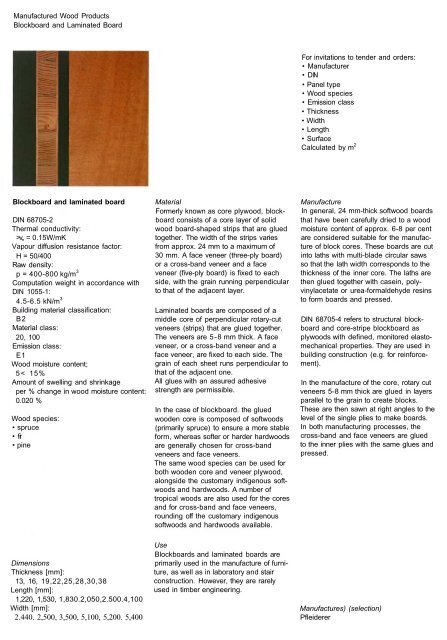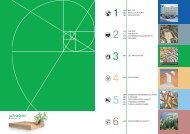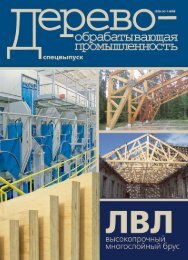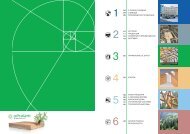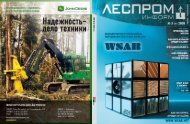Timber Construction
Timber Construction
Timber Construction
Create successful ePaper yourself
Turn your PDF publications into a flip-book with our unique Google optimized e-Paper software.
Manufactured Wood Products<br />
Blockboard and Laminated Board<br />
Blockboard and laminated board<br />
DIN 68705-2<br />
Thermal conductivity:<br />
>v,, = 0.15W/mK<br />
Vapour diffusion resistance factor:<br />
H = 50/400<br />
Raw density:<br />
p = 400-800 kg/m 3<br />
Computation weight in accordance with<br />
DIN 1055-1:<br />
4.5-6.5 kN/m 3<br />
Building material classification:<br />
B2<br />
Material class:<br />
20, 100<br />
Emission class:<br />
E1<br />
Wood moisture content;<br />
5< 15%<br />
Amount of swelling and shrinkage<br />
per % change in wood moisture content:<br />
0.020 %<br />
Wood species:<br />
• spruce<br />
•fir<br />
• pine<br />
Dimensions<br />
Thickness [mm]:<br />
13, 16, 19,22,25,28,30,38<br />
Length [mm]:<br />
1,220, 1,530, 1,830.2,050,2.500.4,100<br />
Width [mm]:<br />
2.440. 2,500, 3,500, 5,100, 5,200. 5,400<br />
Material<br />
Formerly known as core plywood, blockboard<br />
consists of a core layer of solid<br />
wood board-shaped strips that are glued<br />
together. The width of the strips varies<br />
from approx. 24 mm to a maximum of<br />
30 mm. A face veneer (three-ply board)<br />
or a cross-band veneer and a face<br />
veneer (five-ply board) is fixed to each<br />
side, with the grain running perpendicular<br />
to that of the adjacent layer.<br />
Laminated boards are composed of a<br />
middle core of perpendicular rotary-cut<br />
veneers (strips) that are glued together.<br />
The veneers are 5-8 mm thick. A face<br />
veneer, or a cross-band veneer and a<br />
face veneer, are fixed to each side. The<br />
grain of each sheet runs perpendicular to<br />
that of the adjacent one.<br />
All glues with an assured adhesive<br />
strength are permissible.<br />
In the case of blockboard. the glued<br />
wooden core is composed of softwoods<br />
(primarily spruce) to ensure a more stable<br />
form, whereas softer or harder hardwoods<br />
are generally chosen for cross-band<br />
veneers and face veneers.<br />
The same wood species can be used for<br />
both wooden core and veneer plywood,<br />
alongside the customary indigenous softwoods<br />
and hardwoods. A number of<br />
tropical woods are also used for the cores<br />
and for cross-band and face veneers,<br />
rounding off the customary indigenous<br />
softwoods and hardwoods available.<br />
Use<br />
Blockboards and laminated boards are<br />
primarily used in the manufacture of furniture,<br />
as well as in laboratory and stair<br />
construction. However, they are rarely<br />
used in timber engineering.<br />
For invitations to tender and orders:<br />
• Manufacturer<br />
•DIN<br />
• Panel type<br />
• Wood species<br />
• Emission class<br />
• Thickness<br />
• Width<br />
• Length<br />
• Surface<br />
Calculated by m 2<br />
Manufacture<br />
In general, 24 mm-thick softwood boards<br />
that have been carefully dried to a wood<br />
moisture content of approx. 6-8 per cent<br />
are considered suitable for the manufacture<br />
of block cores. These boards are cut<br />
into laths with multi-blade circular saws<br />
so that the lath width corresponds to the<br />
thickness of the inner core. The laths are<br />
then glued together with casein, polyvinylacetate<br />
or urea-formaldehyde resins<br />
to form boards and pressed.<br />
DIN 68705-4 refers to structural blockboard<br />
and core-stripe blockboard as<br />
plywoods with defined, monitored elastomechanical<br />
properties. They are used in<br />
building construction (e.g. for reinforcement).<br />
In the manufacture of the core, rotary cut<br />
veneers 5-8 mm thick are glued in layers<br />
parallel to the grain to create blocks.<br />
These are then sawn at right angles to the<br />
level of the single plies to make boards.<br />
In both manufacturing processes, the<br />
cross-band and face veneers are glued<br />
to the inner plies with the same glues and<br />
pressed.<br />
Manufactures) (selection)<br />
Pfleiderer<br />
Three- and Five-Ply Panels<br />
German building authority certification:<br />
Z-9.1-242<br />
2-9.1-258<br />
Z-9.1-376<br />
Z-9.1-404<br />
Z-9.1-477<br />
Thermal conductivity:<br />
= 0.14 W/mK<br />
Vapour diffusion resistance factor:<br />
11 = 50/400<br />
Raw density:<br />
p = 400-500 kg/m 3<br />
Building material classification:<br />
B2<br />
Material class:<br />
20,100, 100G<br />
Emission class:<br />
E1<br />
Wood moisture content:<br />
12 ± 2 %<br />
lount of swelling and shrinkage<br />
per % change in wood moisture<br />
content:<br />
0.020 %<br />
Wood species:<br />
spruce<br />
larch<br />
i* Douglas fir<br />
.-••nensions<br />
iThickness (three-ply) [mm]:<br />
^12-75<br />
hickness (five-ply) [mm]:<br />
33-80<br />
[Length [mm];<br />
_ 2,500-6,000<br />
i [mm]:<br />
1,000-4,750<br />
Material<br />
The panels consist of three or five layers<br />
of softwood, each glued at right angles to<br />
the adjacent ply. Melamine modified<br />
urea-formaldehyde and phenolic resin are<br />
used as glues.<br />
Since the thicknesses of the single plies<br />
vary according to type and manufacturer.<br />
the elasto-mechanical properties of panels<br />
of equal thickness can also differ considerably.<br />
Applications)<br />
Depending on glue type and the wood<br />
preservative (if any), the panels can be<br />
employed wherever panels of wood<br />
classes 20, 100 and 100 G are allowed<br />
under both the German Building Regulations<br />
and DIN 68800-2.<br />
Once permission has been granted, the<br />
multi-ply panels can be used as effective<br />
and as reinforcing planking in manufacturing<br />
wall, ceiling and roof panels for<br />
wooden houses that are erected as panel<br />
construction systems in accordance with<br />
DIN 1052-3.<br />
Depending on the type of permit granted,<br />
these panels can sometimes be used in<br />
place of laminated construction board as<br />
per DIN 1052-1.<br />
If the edges are carefully covered or<br />
sealed for protection, they can also be<br />
used for large ventilated facades.<br />
Manufactured Wood Products<br />
Three- and Five-Ply Panels<br />
Invitations to tender and orders:<br />
• Manufacturer<br />
• Certification number<br />
• Panel type<br />
• Wood species<br />
• Wood preservation measures<br />
• Thickness<br />
• Width<br />
• Length<br />
• Surface<br />
Calculated per m 2<br />
Manufacture<br />
In the case of softwood plies glued at<br />
right angles to one another, at least 90<br />
per cent of the single sheets must be<br />
grade S10 (DIN 4074-1) and the remaining<br />
sheets at least grade S7.<br />
The surface veneers must be at least<br />
4-9 mm thick, and those oi the inner<br />
plies 4-50 mm.<br />
Manufacturer(s) (selection)<br />
Dold Suddeutsche Sperrholzwerke<br />
Gmach Holzbauwerke<br />
Haas Fertigbau GmbH<br />
Kaufmann Holzbauwerk<br />
Probstel Holzwerke<br />
41


